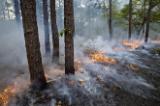 © Steve Vaughn/Panoramic Images (Florida Title Image Large)
© Steve Vaughn/Panoramic Images (Florida Title Image Large)

Altered Processes
Another threat to biodiversity is the dramatic alteration of natural fire regimes, resulting from changes in land-use patterns since the early 1900s. Fire historically played a large role in shaping the landscape and natural community structure of Florida, from the frequently burned pine flatwoods and dry prairie to the infrequently burned hammocks and cypress swamps. Lightning is the main catalyst for natural fires and Florida has the highest incidence of lightning strikes in the country (Chen and Gerber, 1990).
Fire suppression during the early part of the 20th century, however, caused fuels to build up to unnatural levels and led to losses of plant diversity and critical habitat for many wildlife species (Dye, 1989). Although prescribed burning is now a common management practice, liability issues associated with development and an increasing human population severely restrict its use. The result is a loss of ecological integrity, a decline in plant and animal species, a change in soils, and an increased risk of catastrophic wildfires due to the accumulation of organic fuels.
To learn more about fire in Florida’s landscapes, visit the Florida Department of Agriculture and Consumer Services, Division of Forestry website.





